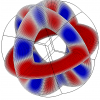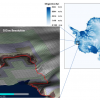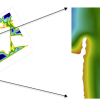Research
The primary focus of ANAG research is in the development of high-resolution and adaptive finite difference methods and software for partial differential equations in complex geometries with applications to DOE-mission applications including porous media flows, magnetohydrodynamics, industrial problems, climate, and fusion energy.
ASCR Applied Mathematics Base Program
The goal of this DoE ASCR Applied Math project is to develop new algorithms for simulating complex systems that are represented by solutions to partial differential equations (PDE). Read More »
REALM for Shallow Water Equations in complex geometries
ANAG and the California Department of Water Resources are collaborating on an open-source hydrodynamic, transport, and particle tracking model (REALM). Estuary systems of bays and channels comprise our problem domains, over which we discretize the shallow water equations. These equations represent the conservation of mass and momentum in one and two dimensions, including the effects of varying bathymetry and source terms. When completed, REALM will contribute to controversial water-policy… Read More »
VCell
We provide the complex geometry PDE solvers used for reaction diffusion problems in the VCell at UConn Health Center. Daniel Graves, Terry… Read More »
Intel Parallel Computing Center for Climate Applications
We are preparing for NERSC-8 "Cori" Xeon Phi architecture by exploring parallelism and many-core performance in climate applications. Read More »
Adaptive Dynamical Core for Climate Applications
We are implementing an atmospheric "dynamic core" for non-hydrostatic atmospheric flows using Chombo. It has a novel higher order time algorithm for thin atmospheres, and an adaptive conservative finite volume discretization of the cubed sphere. Funded under DoE BER's CSSEF program. Hans Johansen (lead) Phil Collela Peter McCorquodale, with Paul Ullrich (ANAG, UC Davis), Bill Collins (LBNL ESD), and Christiane Jablonowski (U Mich). Read More »
BISICLES for Ice Sheet in Climate applications
Recent observations show that the Greenland and Antarctic ice sheets are losing mass at increasing rates. If recent trends continue, ice sheets will make a dominant contribution to the 21st century sea-level rise (SLR), far exceeding the projections of the IPCC's Fourth Assessment Report, AR4. Growing ice mass losses not only could raise sea level, but also could affect other parts of the climate system, such as the Atlantic Meridional Overturning Circulation and its associated poleward heat… Read More »
CACHE Project
The CACHE project is developing communication avoiding versions of geometric multigrid algorithms (see the SC 12 paper). ANAG is providing the code optimization, compiler transformation techniques and overall numerical implementations to optimize performance for emerging architectures. ANAG Members Brian Van… Read More »
D-TEC / AMRStencil
D-TEC D-TEC (also here) defines approaches to construct Domain Specific Languages (DSLs). Different sorts of DSLs are targets for this work; DSLs constructed from existing languages without syntax extension (embedded DSLs) and DSLs with syntax extension to existing base languages. D-TEC funded under the DOE ASCR X-Stack project (also here and here). ANAG's role is abstract numerical algorithm specification and interaction with the Exascale co-design centers, such as ExACT and CESAR. Read More »
EFRC-NCGC: Reactive Transport for Carbon Sequestration
The Center for Nanoscale Control of Geologic CO2 is simulating subsurface pore scale models to explicitly resolve the key fluid-fluid (H2O and CO2) and fluid-solid interface. ANAG is contributing a new high performance simulation capability using EB Chombo, to develop new approaches for representing chemical kinetics and interfacial dynamics in Darcy scale numerical models (upscaling). David Trebotich (ANAG lead), Dan Graves, Terry Ligocki, Brian Van Straalen with Greg Miller (CRD/UCD), Mark Adams (Columbia Univ.), Carl Steefel (LBNL/ESD), Sergi Molins (LBNL/ESD). Read More »
Edge Simulation Lab for Plasma Fusion Modeling
The goal of this work is to develop high-resolution methods for solving continuum kinetic systems in complex phase space geometries. The motivating applications relevant to the DOE Office of Science include the solution of kinetic models of fusion edge plasmas, wherein the preponderant magnetic field requires the efficient discretization of a complicated four-, five-, or six-dimensional phase space. The techniques being investigated include conservative high-order methods based on the method of… Read More »
FASTMath
ANAG is part of the Berkeley Lab team for the FASTMath SciDAC Institute. We are building scalable mathematical algorithms and software tools for high performance computing architectures, specifically using Chombo and EB Chombo. Read More »
Institute for High-Performance Computational Science with Structured Meshes and Particles (HPCS-SMP)
HPCS-SMP is a conceptualization effort for the NSF SI2 program. It proposes an HPC simulation software Institute across multiple science grand challenge areas. Through a series of workshops with domain science simulation experts, we are identifying opportunities to leverage software infrastructure, expertise and collaboration between software developers and application scientists, to evolve new HPC grand challenge simulation capabilities in their fields. Work is a collaboration between… Read More »
XTUNE: Autotuning for Exascale: Self-Tuning Software to Manage Heterogeneity
XTUNE is tasked to develop the first unified autotuning framework that seamlessly integrates programmer-directed and compiler-directed autotuning, so that a programmer and the compiler system can work collaboratively to tune a code, unlike previous systems that place the entire tuning burden on either programmer or compiler. The proposed system will dramatically improve generality and usability of autotuning technology through an integrated, composable collection of tools, including an… Read More »
ECP Subsurface
The Subsurface project is exploring the safe and efficient use of the subsurface for geologic CO2 sequestration, petroleum extraction, geothermal energy, and nuclear waste isolation. It aims to predict reservoir-scale behavior as affected by the long-term integrity of hundreds of deep wells that penetrate the subsurface for resource use. Links DOE ECP project. ECP Subsurface Project ANAG Staff David Trebotich Dan Graves Terry Ligocki Brian Van Straalen… Read More »














